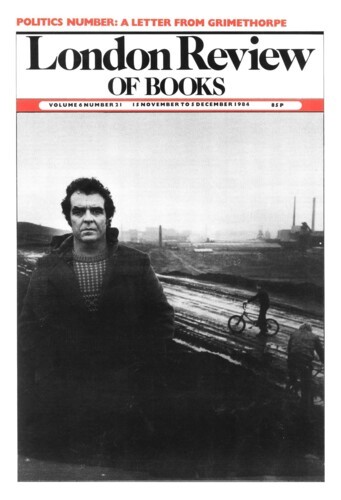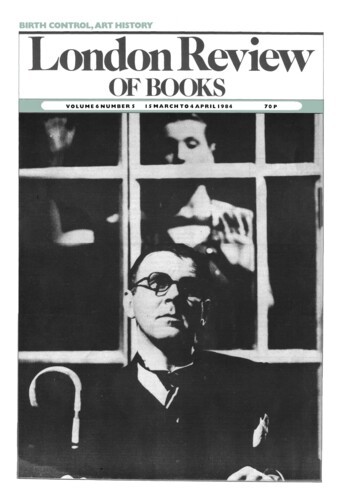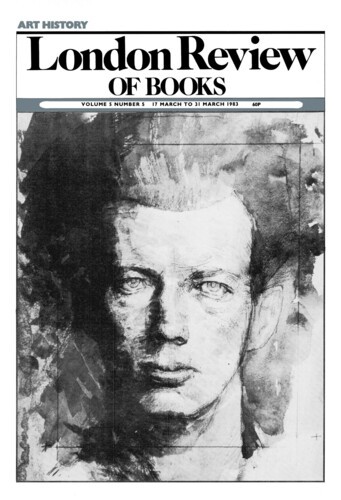Charles Hope
Charles Hope’s most recent book is Titian: Sources and Documents.
Ostentatio Genitalium
Charles Hope, 15 November 1984
The startling claim of Leo Steinberg’s new book is that over the past four centuries the real meaning of much of the religious art of the Renaissance has been lost. He argues that in representations of Christ, both as an infant and as an adult, the genitals had a particular theological significance to which we are now oblivious because of the modern world’s ‘massive historic retreat from the mythical grounds of Christianity’. This may sound like the wilder theories about the Holy Grail or Atlantis, but Professor Steinberg is a serious scholar, and his thesis is buttressed with dozens of visual examples and with a formidable array of learned references. Whether he is right, of course, is another matter: but at least one distinguished historian of Renaissance theology, the Jesuit John O’Malley, who contributes a postscript to the book, seems to find his conclusions broadly convincing, so they deserve to be examined closely.
Two Minds
15 March 1984
Naming the Graces
Charles Hope, 15 March 1984
In the last forty years Kenneth Clark did more than anyone else to create an interest in the art of Renaissance Italy, but Edgar Wind had a much greater influence on the way in which this art has been studied. Both men were outstanding lecturers and gifted writers, and both, in very different ways, were influenced by the work of Aby Warburg. Both, too, were particularly drawn to the early Renaissance in Florence and to the High Renaissance in Rome, to those masterpieces, in fact, which occupy the central place in the English and American canon of great art. But there the resemblance ends. Whereas Clark was a populariser who wore his learning lightly, Wind was exactly the opposite. His best-known work, Pagan Mysteries in the Renaissance, was an attempt to relate the ideas of Neoplatonism to Renaissance paintings and sculptures; and his main contention was that such works could only be fully appreciated by someone deeply versed in this unusually abstruse and now unfamiliar philosophical system. Clark appeals to those who like their art easy, Wind to those who want it difficult.
Do you want the allegory?
Charles Hope, 17 March 1983
A friend of mine recently went to see Pisanello’s fresco of St George and the Princess in the Church of Sant’ Anastasia in Verona. She was soon accosted by the sacristan, who was eager to tell her the story. When he realised that she already knew it, he asked, ‘Do you want the allegory?’ and proceeded to explain that St George symbolised the Pope, the Princess was the Church, the dragon Heresy, and so on. Pisanello himself would surely have been surprised by this interpretation. After all, if he had meant to show such an allegory, he could simply have painted a Pope with the standard personifications of the Church and Heresy, rather than the familiar legend of a popular saint. It was not until the Counter-Reformation, a century later, when the historical status of St George began to be doubted, that allegorical readings of his ‘life’ were first proposed. The sacristan’s explanation, in fact, sounds like one of those fanciful elaborations which become attached to pictures over the centuries and which guides everywhere love to relate. But it also resembles the interpretations of Renaissance works of art now proposed by many scholars.
Podcasts & Videos
Giorgione and the Problem of Attribution
Charles Hope
Charles Hope tries to find Giorgione at the Royal Academy’s exhibition, In the Age of Giorgione.
Pieces about Charles Hope in the LRB
Titian’s Mythologies
Thomas Puttfarken, 2 April 1981
If Titian’s reputation were to be assessed by the number and quality of the monographs devoted to him during this century, it would be hard to believe that he was one of the greatest...
Read anywhere with the London Review of Books app, available now from the App Store for Apple devices, Google Play for Android devices and Amazon for your Kindle Fire.
Sign up to our newsletter
For highlights from the latest issue, our archive and the blog, as well as news, events and exclusive promotions.



